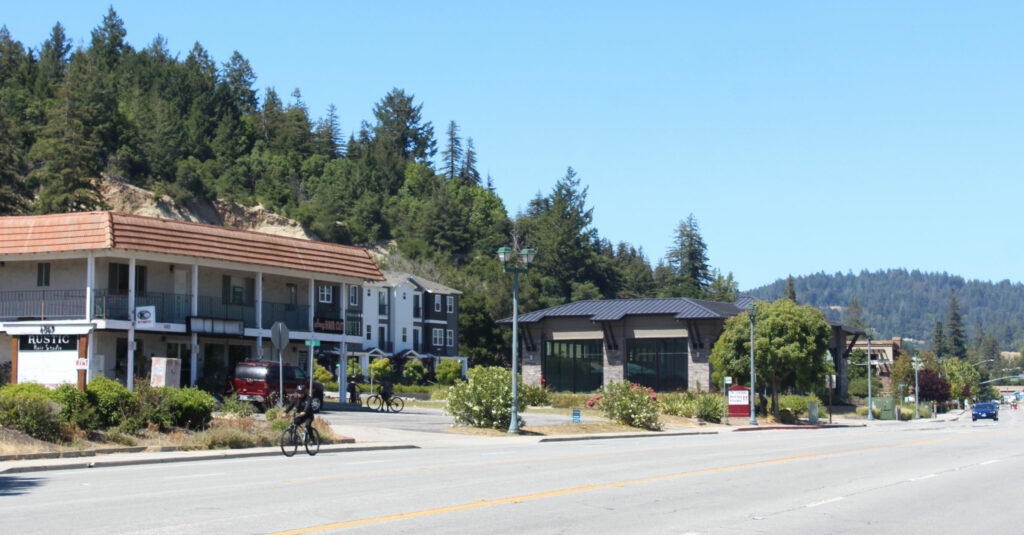
During the joint special meeting of the Scotts Valley Council and Planning Commission, held at the end of last month, the City’s plan for future residential development came into focus.
Over the upcoming eight years, the City is required to plan for 1,220 homes, including 649 units for people making below moderate incomes, and submit its roadmap for accomplishing this—called the Housing Element—to the State Department of Housing and Community Development by the end of the year.
Council and the Planning Commission had convened, in April, to see the course Kimley-Horn, its Housing Element consultant, had charted.
The path included opportunities for the building of 3,407 homes, including 3,177 above moderate income units, 48 moderate income units and 182 low and very low income units.
The consultant noted HCD recommends a buffer of about 15-30% above what is required.
Overall this draft included 279% more housing than required (762% more above moderate, 31% more moderate, and 28% more low and very low than mandated).
By the end of May, the consultant had amended the plan to feature 2,173 units (an overall 78% buffer beyond the 1,220-unit mandate): bringing the number of above moderate units down to 164% more than required (1,099 in total), 9% more moderate units than required (168), and 40% more low and very low units than required (906 split between the two categories).
After community outreach that included a workshop that was cut off in the middle when the Zoom teleconference system shut down, a second joint Planning Commission-Council study session was convened.
“I think that the word of the day is ‘flexibility,’” said Vice Mayor Randy Johnson, at the June 28 gathering of community leaders. “This is a brave new world of structure, of mandates, of the state.”
Johnson called a public comment from a Yes In My Backyard activist who said Scotts Valley is doing as little as possible to build housing “ridiculous,” saying staff has done a good job within a tight timeframe. He noted that some landowners want their properties to be used for residential development, while others don’t.
“It’s an interesting mix,” he said, inquiring about site selection. “Who is the guardian of the gate here?”
Community Development Director Taylor Bateman said staff has been putting a lot of thought into just these sorts of decisions.
“When we brought forward—a couple months ago—a plan, we had a number that was a little bit high on the market rate housing,” he said. “We went back and found properties that we could remove from the list that would help with that number. So, that was just our best run at it.”
He said the plan can be refined further.
Though he hadn’t responded to the question directly, Johnson was satisfied.
“I think that’s a good response,” he said. “Because I think that people are looking for an ability to massage this in some ways that meets their needs, meets the community’s needs, meets the State’s needs, moving forward. And it’s an ambitious effort.”
Johnson said Scotts Valley residents have found even just the 1,220 home mandate daunting.
“That’s scary for a lot of citizens, once they finally find out,” he said. “I think we have to be able to listen and react and be sensitive to all these different inputs and needs.”
He added Scotts Valley has struggled with development challenges because of previous actions by the State of California.
“I can’t really recall more of an incursion or an assault on local government—maybe when they took away redevelopment,” he said, referring to the 2012 dissolution of redevelopment agencies. “Just out of the blue, it was gone. And this was kind of done in the same way, where ‘one size fits all.’ And you have a top-down decision.”
Johnson also criticized “political maneuvering” within the Association of Monterey Bay Area Governments, which he characterized as resulting in Santa Cruz County having to create “more than its fair share,” of housing, compared to Monterey County.
“But it’s the hand we’ve been dealt with,” he said. “This is a tough row to hoe. This is not easy for anybody.”

Councilmember Derek Timm represented Scotts Valley on AMBAG at the time; he voted against the housing allocation.
He, too, fired back against the YIMBY detractor, who had criticized him for looking to Huntington Beach’s experience of fighting against HCD and the Regional Housing Needs Allocation process, for guidance—at least in some respects.
“I did see that Huntington Beach lost their lawsuit,” Timm said. “I did not suggest that we not file a Housing Element, which—they took that stance. I suggested that we look at the comments they made and the constitutional arguments that they were making that the State had violated their rights as a jurisdiction in the way that they went about the process.”
He pointed to a review done by the State auditor, which Timm said found flaws in HCD’s methodology.
“They found that HCD failed to provide correct assessments to the regional (councils of governments),” he said. “They didn’t come in with the correct numbers to begin with. Then, they didn’t follow the State law requirements when they came to the COGs. They weren’t following the rules that they were supposed to play by. And then they didn’t factor in housing vacancy rates correctly. So, that insufficient oversight and lack of support is what the State auditor said was the flaw in HCD’s process.”
That led the AMBAG to generate inflated RHNA numbers, according to Timm.
“The State auditor said, ‘You know, those could’ve been inflated by hundreds of thousands of units state-wide,’” he said. “This isn’t me saying this. This is the State auditor who looked at the process. They also said that the Finance Department for the State came in with inaccurate assumptions.”
It gave HCD the wrong data relating to household size and growth rates, Timm added.
He was referring to a March 2022 report submitted by Acting California State Auditor Michael S. Tilden, which found that most of the Department of Finance’s projections “were reasonably accurate,” but could be improved. It revealed errors in two of three regions examined, when it came to HCD’s evaluation of housing needs (in one case the agency overshot by 2,500 homes).
“You have this situation where all these local governments are being handed numbers based on flawed assumptions, OK?” Timm said. “That’s frustrating for local governments. And so, to the vice mayor’s point, right? Our jurisdiction’s doing the best we can. But it doesn’t mean we shouldn’t fight for our public’s voice around the fact that the State screwed up. So, we should absolutely be doing this under protest. It doesn’t mean we shouldn’t comply with what’s going on. Because at the same time we have to follow the law. If we don’t, we’re gonna get—we’re gonna have it handed to us.”
Councilmember Donna Lind noted that last year, when she was mayor, she went to Sacramento with City Manager Mali LaGoe—alongside municipal leaders from across California—asking for financial support to implement affordable housing mandates.
“How do we get a developer to do it?” she said. “It would have been an opportunity for the State, at that time—with almost a two-hundred-billion surplus—to be able to help all the jurisdictions accomplish what we’d been given. Sadly, there really wasn’t a response to that. So, we’re doing the best we can, and trying to work with developers to accomplish this—and in a very short period of time.”
Lind thanked community members for providing input throughout the process.
“That means a lot too,” she said. “Because we need the emails. We need to hear from those of you who say, I have a property; I want to be involved. Or, I have a property; I don’t. Is there another way? Thank you for taking that time to be here.”

Planning Commissioner Chuck Maffia commented on the proposed shift of the 50/50 residential-commercial requirement for projects on Scotts Valley Drive to 70 residential / 30 commercial—which several community members argued didn’t go far enough.
“Years ago, that was Highway 17,” he said. “Mount Hermon (Road) is now our commercial corridor. To me, knowing what the marketplace is today for interest rates and desirability for commercial real estate, it just doesn’t make sense, or maybe (it’s) not feasible at this point in time to have a huge component for commercial.”
He said it makes a lot of sense to have commercial on the ground floor with residential above along Scotts Valley Drive, which he said was a good place for that kind of development, given the public transit access out front.
Maffia said he was confused about what was going on with the effort to change the definition of “family” through the Housing Element process, and used the man to his left, Planning Commissioner Steven Horlock, to illustrate the question.
“I totally didn’t understand it,” Maffia said. “I almost think if Steve and I moved in together we’d become a family. Is that how the definition really reads?”
Bateman said the City is simply trying to comply with State law requirements.
“As far as the makeup that emerges from that and compositions, it can probably be varied,” he said. “And a lot of combinations are acceptable.”
Maffia followed up: “So, is it just, two people living together constitutes a family?” he wondered. “Is that what the law says?”
Ines Galmiche, a Kimley-Horn planner, said the issue was the City’s current definition of family had limitations on the number of unrelated persons that can reside together.
“This is mostly relating to group homes and those types of housing units,” she said. “My understanding is, in response to this, the State does not allow for definitions of family to include these specifications that the City’s definition currently has. So, the amendment would just be to remove that language.”
Lind said that, decades ago, there had been problems with nuisance group homes and suggested that may be why the current definition reads the way it does.
Councilmember Allan Timms thanked staff for their “tremendous effort” in producing the Housing Element plans, to date.
“It’s a very complicated subject,” he said. “The work to get this all together in this short time was just incredible.”
He said he was pleased to see how quickly planners were able to shave down the number of projected residences.
Early on in the study session, the consultant showed a table indicating Scotts Valley had shaved 8 percentage points off the number of project homes. A public commenter had pointed out that the numbers didn’t seem to add up.
The officials confirmed there had been a number calculation error and worked throughout the course of the meeting to update the key table.
Right at the conclusion the updated data was unveiled, showing Scotts Valley’s draft Housing Element includes plans for 2,172 homes, which is still 78% above the RHNA requirement.
The reworked table featured 1,098 above moderate income units (a 153% buffer), 168 moderate income units (a 9% buffer), and 906 low and very low income units (a 40% buffer).
Just over the hill, Bay Area municipalities are about a year ahead, as that region is on a slightly different timeframe, compared to AMBAG.
Earlier this year, Milpitas succeeded with a 30% buffer of low and very low income housing and a 62% overall buffer; Campbell got its Housing Element certified with a 30% buffer across the board; Mountain View made it past the finish line with a 16% buffer for below moderate units and a 45% total buffer; and Los Altos Hills got the stamp of approval with a 15% buffer across income categories.
On July 5, Scotts Valley sent its draft Housing Element to HCD for review.
Now, the total is down to 2,151, a 76% buffer above the mandate (a two-percentage-point drop), with 1,087 above moderate (a 161% buffer), 166 moderate units (8% buffer) and 898 low and very low (a 38% buffer). It expects to get comments back from HCD in early October.












